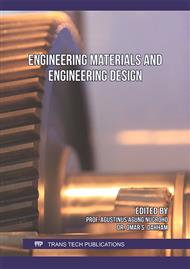[1]
S. Kasen, Thermal Management at Hypersonic Leading Edges, (2013).
Google Scholar
[2]
C. P. Leonard, R. M. Amundsen, B. Walter, Hyper-X Hot Structures Design and Comparison With Flight Data, AIAA/CIRA 13th International Space Planes and Hypersonic Systems and Technologies, (2005).
DOI: 10.2514/6.2005-3438
Google Scholar
[3]
C. Wang, F. Li, Z. C. Ding, L. Zhang, Numerical simulation of hypersonic flow around an aerospace plane by Parallel RANS based CFD, Procedia Engineering, Vol. 61, (2013).
DOI: 10.1016/j.proeng.2013.07.087
Google Scholar
[4]
S. Narendar, R. Gopikrishna, Evaluation of structural integrity of tactical missile ceramic radomes under combined thermal and structural loads, Procedia Structural Integrity, Vol. 14, (2019).
DOI: 10.1016/j.prostr.2019.05.012
Google Scholar
[5]
J. Manu, G. Vinod, R. N. Mathews, Thermo-Structural Analysis of Thermal Protection System for Re-Entry Module of Human Space Flight, Vol. 5, (2016), 125-137.
Google Scholar
[6]
B. Esser, J. Barcena, M. Kuhn, A. Okan, L. Haynes, S. Gianella, A. Ortona, V. Liedtke, D. Francesconi, H. Tanno, Innovative thermal management concepts and material solutions for future space vehicles, Journal of Spacecraft and Rockets, Vol. 53, (2016), 1051-1060.
DOI: 10.2514/1.a33501
Google Scholar
[7]
Q. Lu, G. Jiang, X. Zhang, D. Deng, Design of lightweight graded hot structures for hypersonic vehicles, (2013), 838-841.[8] D. E. Glass, Ceramic Matrix Composite (CMC) Thermal Protection Systems (TPS) and Hot Structures for Hypersonic Vehicles, 15th AIAA International Space Planes and Hypersonic Systems and Technologies Conference, (2008), 1-36.
DOI: 10.2514/6.2008-2682
Google Scholar
[9]
A. Purwar, Thermo-structural Design of Hypersonic Vehicle Sharp Leading Edges for Thermoerosive Stability Using Finite Element Modelling, 31st International Symposium on Shock Waves 2, (2019), 1027-1034.
DOI: 10.1007/978-3-319-91017-8_128
Google Scholar
[10]
D. R. Tenney, Materials and Structures for Hypersonic Vehicles, Journal of Aircraft, (1989).
Google Scholar
[11]
W. Krenkel, Carbon Fibre Reinforced Silicon Carbide Composites (C/SiC, C/C-SiC), Handbook of Ceramic Composites, (2006), 117-148.
DOI: 10.1007/0-387-23986-3_6
Google Scholar
[12]
T. Reimer, I. Petkov, D. Koch, M. Fried, C. Dellin, Fabrication and Characterization of C/C-SiC Material made with Pitch-based Carbon Fibers, (2015), 1-17.
DOI: 10.1002/9781119183860.ch28
Google Scholar
[13]
W. Li, T. Cheng, D. Li, D. Fang, Numerical Simulation for Thermal Shock Resistance of UltraHigh Temperature Ceramics Considering the Effects of Initial Stress Field, Vol. 2011, (2011).
DOI: 10.1155/2011/757543
Google Scholar
[14]
A. Viviani, G. Pezzella, Aerospace Technology Aerodynamic and Aerothermodynamic Analysis of Space Mission Vehicle, (2015).
DOI: 10.1007/978-3-319-13927-2
Google Scholar
[15]
E. H. Hirschel, Basics of Aerothermodynamics, (2005).
Google Scholar
[16]
A. Nisar, R. Hassan, A. Agarwal, K. Balani, Ultra-high temperature ceramics: Aspiration to overcome challenges in thermal protection systems, Ceramics International, Vol. 48, (2022), 8852-8881.
DOI: 10.1016/j.ceramint.2021.12.199
Google Scholar
[17]
M. Dharavath, P. Manna, D. Chakraborty, Tip-to-tail numerical simulation of a hypersonic airbreathing engine with ethylene fuel, Acta Astronautica, Vol. 128, (2016), 107-118.
DOI: 10.1016/j.actaastro.2016.07.014
Google Scholar
[18]
T. K. S. Murthy, Computational Methods in Hypersonic Aerodynamics, Kluwer Academic Publishers, (1991).
Google Scholar
[19]
L. Fu, M. Karp, S. T. Bose, P. Moin, J. Urzay, Shock-induced heating and transition to turbulence in a hypersonic boundary layer, (2020).
DOI: 10.1017/jfm.2020.935
Google Scholar
[20]
R. Stadelmann, ZrB2-SiC based ultra high temperature ceramic composites: Mechanical performance and measurement and design of thermal residual stresses for hypersonic vehicle applications, (2015).
Google Scholar
[21]
X. Sun, H. Yang, T. Mi, Thermo-Structural Behaviour Prediction of the Nose Cap of a Hypersonic Vehicle Based on Multifield Coupling, International Journal of Aerospace Engineering, Vol. 2020, (2020).
DOI: 10.1155/2020/3850283
Google Scholar
[22]
F. Chen, H. Liu, S. Zhang, Coupled heat transfer and thermo-mechanical behavior of hypersonic cylindrical leading edges, International Journal of Heat and Mass Transfer, Vol. 122, (2018), 846-862.
DOI: 10.1016/j.ijheatmasstransfer.2018.02.037
Google Scholar
[23]
A. Rasouli, H. Toopchi-Nezhad, Coupled vs uncoupled analysis of one-way RC-slabs under nearby air explosions, International Journal of Advanced Structural Engineering, Vol. 10, (2018), 421-437.
DOI: 10.1007/s40091-018-0206-0
Google Scholar
[24]
T. J. Coakley, C. C. Horstman, J. G. Marvin, J. R. Viegas, J. E. Bardina, M. I. Kussoy, M. Field, P. G. Huang, Turbulence Compressibility Corrections, (1994).[25] R. G. J. Sager, Compressible dissipation, pressure dilation and pressure induced diffusion in hypersonic turbulence modeling, Vol. 9, (1996).
Google Scholar
[26]
C. Hu, Y. Sakka, B. Jang, H. Tanaka, T. Nishimura, S. Guo, S. Grasso, Microstructure and properties of ZrB2-SiC and HfB2-SiC composites fabricated by spark plasma sintering (SPS) using TaSi2 as sintering aid, Journal of the Ceramic Society of Japan, Vol. 118, (2010), 997-1001.
DOI: 10.2109/jcersj2.118.997
Google Scholar
[27]
S. Meng, H. Chen, J. Hu, Z. Wang, Radiative properties characterization of ZrB2-SiC-based ultrahigh temperature ceramic at high temperature, Materials and Design, Vol. 32, (2011), 377-381.
DOI: 10.1016/j.matdes.2010.06.007
Google Scholar
[28]
M. May, G. D. Rupakula, P. Matura, Non-polymer-matrix composite materials for space applications, Composites Part C: Open Access, Vol. 3, (2020).
DOI: 10.1016/j.jcomc.2020.100057
Google Scholar
[29]
R. Luo, T. Liu, J. Li, H. Zhang, Z. Chen, G. Tian, Thermophysical properties of carbon/carbon composites and physical mechanism of thermal expansion and thermal conductivity, Carbon, Vol. 42, (2004), 2887-2895.
DOI: 10.1016/j.carbon.2004.06.024
Google Scholar
[30]
M. Patel, K. Saurabh, V. V. B. Prasad, J. Subrahmanyam, High temperature C/C-SiC composite by liquid silicon infiltration: a literature review, Bull. Mater. Sci, Vol. 35, (2012), 63-73.
DOI: 10.1007/s12034-011-0247-5
Google Scholar


